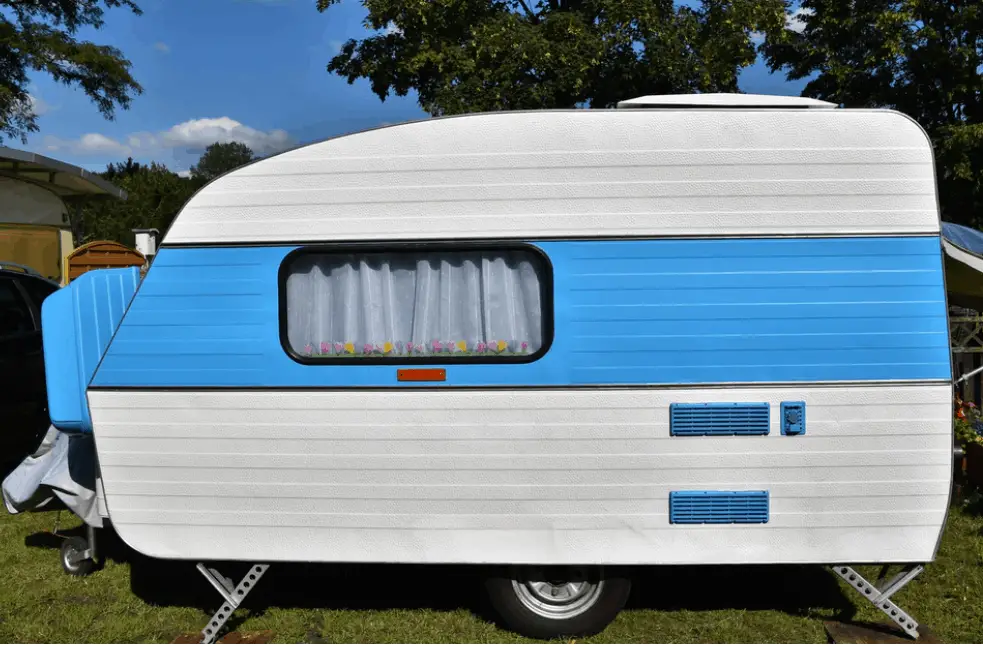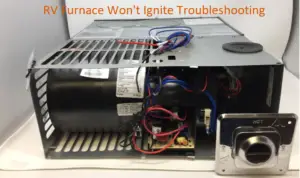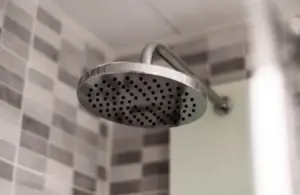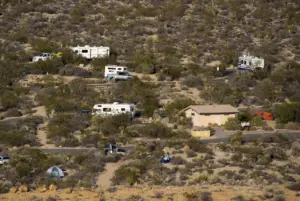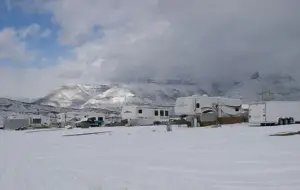You have just bought a new RV, or you have had one for a while, the point is you want to protect it, and you don’t know whether you should be okay covering it just with a normal tarp.
Campers or travel trailer do cost a lot and protecting them is utmost important. Winter snow or summer heat can be tough on the trailer roof.
Also, you don’t want bird droppings, dust to grow there on the roof. And hence, you want the answer to whether one can cover RV with a tarp.
Lets find out.
Should You Cover RV With A Tarp
To answer this question, yes, you should cover your RV. However, Covering RV or travel trailer with regular traditional tarp should be avoided. These do more damage than protecting your RV. Regular tarps are not breathable and can develop moisture resulting in mold.
Its a better idea to cover the RV or travel trailer with specially made quality RV covers.
Get a cover or Tarp specially designed for RV, that will be much better approach if you cannot have your RV inside storage or garage.
Blue tarps are not breathable and hold moisture, which can result in mold. They may not provide the protection you need.
Also, blue tarp itself can get damaged by either fray, shred, blowing off, or moving around.
Tarps have gained many purposes in the world of transport. Tarps are used outdoors, protecting commercial items, construction vehicles, machines, and many more.
You want to make sure the material is correct for your RV. Your goal is to find something lightweight and durable at the same time.
There are pros and cons to using an RV specific tarps or covers as well.
PROS
- Tarps protect your RV from UV radiations
- Keeps the roof shielded from snow, rain and sun
- Protects RV roof from aging
- Saves you money as you won’t need a storage unit.
- Tarps reduce the frequency of maintenance you will need to undergo.
CONS
- There are risks of wear and tear
- It can cause a lot of damage if not used properly
- Folding and storing the tarp is a tedious process.
- Getting wrong type can do more harm than help
- High winds can result in cover flapping and may not remain secure.
- Fitting the tarp on RV can be tough job
Should You Completely Avoid Tarp Or Cover?
Having said that covers can cause the damage, i have seen so many RVers who use covers every year and have no issues with them. Covers or right tarp for RV is one of the lowest cost solution to protect the RV.
If you cannot afford a storage or don’t have a garage then getting a cover on is the minimum best you can do. RVs do cost lot of money and its an investment for long terms, so by all means get a cover when options are not there.
Bird droppings, dust, leaves can really get the roof dirty. You definitely don’t want to clean and repair the roof because of this.
Helps In All Seasons : A summer sun hitting directly the travel trailer roof can be concerning. So, you do want that cover in between. And then the spring rain and winter snow will only make it worse.
Read : Great Tips to Use Travel trailer in Winter
So, when the storage is not available covers or tarp is the right approach. A good thing with covers is once you get used to them, you will have no problem whatsoever.
Snow : A snow accumulation can however be tough situation. Removing snow from the top can result in tearing the cover. So, if you do live in high cold region then be sure to look for alternatives. That’s the best policy.
Building a RV Shelter : Some people who protect their RV to greater extent do build their own shelters. That can be great if you have some space available. It can protect against the snow and heavy rains.
Better Covers : Getting a good quality Cover like the one by ADCO is much better thing to do. With Breathable covers you don’t have to worry about moisture and mold.
Do RV covers/tarps Cause Mold?
Yes, covers and tarps can result in mold. A cover or tarp without much air circulation can result in moisture. Lack of drying can then result in mold. If it goes unnoticed then the roof will take the beating.
Having to repair the roof is something that every RV owner fears. Yes, you need to do basic maintenance and repair but if its due to cover then you only end up cursing yourself.
Read : You Complete Guide for Maintaining the RV Roof
There are ways to control and prevent this, though.
A breathable cover helps keep moisture away. Other options include using an air conditioner or fan to keep the RV fresh. The best solution is generally a dehumidifier; these work perfectly.
Is RV storage a better solution?
Naturally, there are other storage solutions other than using a tarp, let’s have a look at what this entails.
A storage facility is the best option out of them all. But, its costly. You can find better low cost one though. If you have a high cost Class A Motorhome then you obviously need to be more protective.
There are simply cheaper options with regards to storing your RV, and you can determine which solution is the best by considering what your budget can handle.
Building your own shade or shelter can work great as you will have better air circulation.
Garage for RV need to be larger with a bigger door. A costly RV should always be stored properly, but if you own a low cost travel trailer then covering it can be okay.
Read : Should you store RV with vent open or closed
If you do use a tarp or cover, make sure you avoid trees and grass as the RV can get damage by it. If you do not move your RV often enough, you will get flat spots underneath the tires.
Different type of tarps for RV
When it comes to choosing a tarp for RV, you may not even know where to start. There are multiple options when it comes to types of tarps available for your RV. There are four recommended types.
VINYL
Vinyl tarps have a couple of features that are highly beneficial when choosing a tarp for your RV.
They have two primary aspects that give them their selling point.
Vinyl tarps are very durable and waterproof. This naturally means that vinyl is more expensive than the other three mentioned types.
Although vinyl is considered the best material, its price range is generally what turns people off when having to decide whether or not they want to purchase this type of tarp.
They are ideal for covering heavy-duty vehicles such as trucks.
MESH
Mesh tarps are another option; they do, however, pose some issues. Firstly they lack ultimately protecting your RV.
There are a couple of things a mesh tarp is suitable for, but RV storage is not a recommended option.
It does not adequately protect against UV rays, and moisture will seep through. Mesh tarps are generally used as privacy or light screening. Mesh is not highly recommended as the ideal tarp for your RV.
CANVAS
Canvas is one of the most popular tarps purchased, although poly is a better option, which will be discussed in a moment.
It provides breath-ability and some water-resistant aspects. The down point regarding canvas is that it has a high-cost range, there are concerns regarding durability, and the minimal waterproofing element is a downfall.
POLY
Poly mimics the elements of a vinyl tarp and is produced at a low cost. The majority of tarps available in the store will be made from poly.
These poly tarps can either be a cheap poly production or a triple-layered tarp which can be custom fitted and ventilated.
Poly is perfect for storing your RV outdoors.
Tarp Thickness For RV
Checking the thickness of the tarp and knowing how to check the thickness and material used, which can help you determine which tarp is the best fit for you.
The thickness of a tarp is measured in mils; this is 1/1000 of an inch.
You want to find a minimal thickness of 5 mils. If you need a more heavy-duty tarp for covering RVs, you need to consider a heavy-duty tarp of a minimum thickness of 23 mils.
A proposed dilemma is that most distributors do not indicate the mils thickness in these type of metrics. Instead, they refer to the thicknesses as regular, super, or super heavy-duty tarps.
Using Regular Tarp For RV Or Travel Trailer
To state it briefly, regular tarps wear out very quickly. If you have used an ordinary blue tarp, you should be familiar with how quickly regular tarps deteriorate.
- The majority of regular tarps are only six mils thick and last up to max five years if exposed to constant direct sun.
Although five years don’t seem too bad, there will be deterioration taking place that is not visible to the naked eye. So situations can occur without your knowledge, such as water seeping through, resulting in mold.
Do you get RV specific tarps? And are they any good?
There are manufacturers that produce tarps specifically for RVs. This means that these covers will have all the elements required to keep your RV in tip-top shape.
As the mentioned above, poly is a number one choice for an RV tarp, and that is what most of these manufacturers use, three layered poly.
- These layers protect against UV rays; they are waterproof and allows moisture to escape.
- Majority of tarps made explicitly for RVs have a multi-year warranty and come with accessories such as tie-downs and storage bags.
Some of the manufacturers design the tarps to have stretching corners to make it convenient to secure the tarp to the RV. Other things about RV made tarps include:
- Vents that are integrated.
- Access to the RV, while it is in storage, is provided through zippered panels.
- You can achieve a custom fit through multiple drawstrings and cords.
- You get a bag to store your tarp when not being used.
- These tarps come with heavy-duty roof paneling.
- Some grommets won’t rust.
How Do You Cover An RV With A Tarp
Great! Now you have your answers about what types of tarps there are, what each is recommended for, and the pros and cons of each.
But now you need to put the tarp on your RV. Here are three easy steps to follow when having to endure this process.
STEP 1
Set up your tarp directly, inform of your RV, and make sure it is centered. Unroll your tarp towards the back of the RV and then unfold the tarp so that it hangs off both the front and backside.
STEP 2
Next, you want to hook the cords into the metal rings on the side of the tarp. Make sure to run the cord through the side rail of the trailer and back up the same ring or towards an adjacent ring.
STEP 3
The final step is to tuck the overhanging flaps of the tarp towards the freight. Secure the cargo strap over the front flaps.
Secure the second strap over the rear of the tarp. Hook the ends of the straps to the guard rail of the RV on one side and make sure to thread the strap through the RVs mounted winches on all sides.
Furthermore, you want to twist the whites to secure them properly. Finally, insert the winch bar into the ratchet holes. Tighten down ant excess tarp flaps.
In Conclusion
To conclude, there are multiple options when it comes to protecting your RV. I hope this article provided enough information for you to go forth and purchase the tarp/cover of your choice with confidence.
The world of RVs offers so many recreational options, and making sure your RV is protected is necessary if you want to keep reliving the happy moments on the journey you took with your trusted RV.

